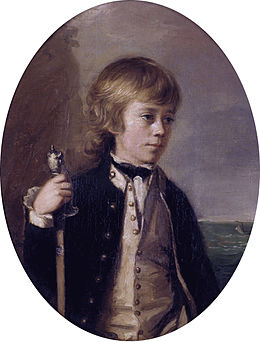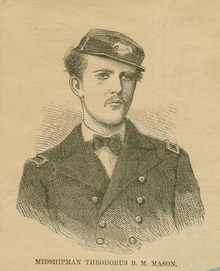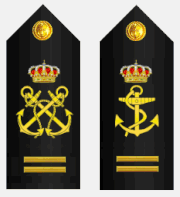Midshipman
Commonwealth countries which use the rank include Canada (Naval Cadet), Australia, Bangladesh, Namibia, New Zealand, South Africa, India, Pakistan, Singapore, Sri Lanka, and Kenya.
In many Romance languages, the literal translation of the local term for "midshipman" into English is "Navy Guard", including the French garde marine, Spanish guardia marina, Portuguese guarda-marinha, and Italian guardiamarina.
[7] Beginning in 1661, boys who aspired to become officers were sent by their families to serve on ships with a "letter of service" from the crown, and were paid at the same rate as midshipmen.
[8] The letter instructed the admirals and captains that the bearer was to be shown "such kindness as you shall judge fit for a gentleman, both in accommodating him in your ship and in furthering his improvement".
[5][12] The rating of midshipman-by-order, or midshipman ordinary, was used specifically for graduates of the Royal Naval College, to distinguish them from midshipmen who had served aboard ship, who were paid more.
[15][A 1] Boys aspiring for a commission were often called young gentlemen instead of their substantive rating to distinguish their higher social standing from the ordinary sailors.
Occasionally, a midshipman would be posted aboard a ship in a lower rating such as able seaman but would eat and sleep with his social equals in the cockpit.
The rest were from commercial or working class backgrounds, and because of the advantages possessed by the nobility and professional sailors, their chances of promotion to lieutenant were slim.
On smaller ships, midshipmen were instructed by a senior master's mate, often a passed midshipman, who taught them mathematics, navigation, and sailing lore.
[30] In 1838 a Royal Commission, presided over by the Duke of Wellington, recommended the institution of the rank of mate as an official step between midshipman and lieutenant.
[32] Midshipmen had similar duties and responsibilities as in the Royal Navy, and were typically young men between the age of 14 and 22 in training to become a naval officer.
[39][40] After passing the examination for lieutenant, midshipmen were commissioned as sub-lieutenants, and were transferred to the Royal Naval College, Greenwich, which opened in 1873 as the 'University of the Navy'.
[43] In 1913, increasing demand for officers led to recruitment of 18-year-old graduates of public schools, which was called 'Special Entry', and was conducted separately from Selborne scheme cadets.
[49] Congress formally authorized the establishment of the United States Military Academy in 1802, but it took almost 50 years to approve a similar school for naval officers.
[50] One major reason for the delay was that Navy leaders preferred the apprenticeship system, citing famous officers such as Nelson and the captains of the War of 1812 who did not attend a formal naval school.
[50] He formed a council led by Commodore Perry to create a new system for training officers, and turned the old Fort Severn at Annapolis into a new institution which would be designated as the United States Naval Academy in 1851.
In 1912, Congress authorized commissioning midshipmen as ensigns on graduation day, and ended the previously required two years of post-graduation sea service as warrant officers.
Today Australia, New Zealand, South Africa, Pakistan, India, Singapore, Sri Lanka, Bangladesh, Kenya, and Brunei use the rank.
Two popular stories give origins for the term: the first claims that it arose from a shortage of handkerchiefs among midshipmen, who would consequently use their sleeves to wipe their noses.
During the second term officer cadets spend 6 weeks in Initial Sea Time (IST), serving aboard capital warships as junior ratings.
[83] Cadets initially spend a year training at the South African Naval College in Gordon's Bay, about 55 km southeast of Cape Town, and upon graduation are commissioned as midshipmen.
[84] Midshipmen can then study for three more years at the South African Military Academy, and upon graduation receive a B Mil degree from Stellenbosch University.
[89] In the modern United States Navy, a midshipman is classified as an officer of the line, though their exercise of authority is limited by their training status.
[103] Midshipmen at the US Naval Academy, US Merchant Marine Academy, and in the NROTC wear uniforms that comply with standards established for commissioned officers of the Navy, with shoulder board and sleeve insignia varying by school year or midshipman officer rank as prescribed by Chapter 6 of Navy Uniform Regulations.
[107] Midshipmen at the United States Merchant Marine Academy study a similar core curriculum, except they are split into deck (navigation oriented) and engineering programs.
Additionally, they typically spend a year at sea working as cadets on U.S. flagged merchant ships, visiting ports around the world.
At graduation they have two options: (1) a job in the maritime industry ashore or sailing aboard commercial US-flagged vessels, plus a US Navy Reserve commission,[A 9] or (2) an active-duty commission in any of the United States Uniformed Services (Army, Marine Corps, Navy, Air Force, Coast Guard, National Oceanographic and Atmospheric Administration, or United States Public Health Service) as an ensign or second lieutenant.
Today, adelborsten train at the Royal Netherlands Naval College (Dutch: Koninklijk Instituut voor de Marine) for 3 years.
Unlike midshipmen in the Royal Navy, the Gardes trained mostly on shore and focused on military drill and theory rather than practical skills in gunnery, navigation and seamanship.
[112] To fill the gaps, volunteers were temporarily recruited from the merchant service; they were allowed to hold permanent rank in the navy starting in 1763.












